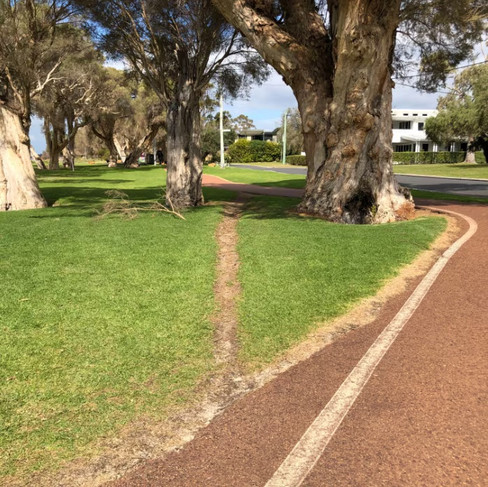Designing better public spaces using desire paths
- World Half Full

- Apr 23, 2023
- 4 min read
Updated: Jan 7, 2024
COMMUNITY


A quarter of a million people pass through Denmark’s busiest train station every day. Many of those who use Copenhagen’s Nørreport Station are on foot and on bikes, navigating their way around the trams, buses and cars that also use the surrounding area. Before a redesign of the station and its surrounds, the combination was, in the words of the company that revamped the space, “a chaotic island surrounded by traffic” that neglected pedestrians and cyclists. As designers sought to unravel the chaos and create a better, safer space, they paid careful attention to how people were already using the area.
Dan Stubbergaard, founder of Danish design firm Cobe, noted that “in winter, organic pathways emerged in the snow created by people’s movements in and around the station, clearly showing us where there was a need for passages, shelter and bicycle parking.”
What has emerged is a renewed, functional public space that connects well to other parts of the city. The ground-level infrastructure of the underground rail hub consists of floating, circular roofs above glass pavilions, surrounded by sunken bicycle beds encircled by the paths that mimick those made in the snow.
Dr Mike Harris, an urban design researcher at the University of New South Wales (UNSW), says the success of Nørreport Station shows how paying attention to people’s behaviour results in better city design. And with more people living in built-up environments, those designing urban spaces are increasingly examining desire lines or desire paths, he adds.
A desire line or desire path is an unplanned trail that forms as a result of traffic, either by humans or animals, and often veers away from established paths.
“The idea behind the desire line is that it is really about the path of least resistance,” Harris says. “People take it simply because it’s easy. That’s human nature with so many things. People will tend to choose the option that is the easiest.”
In recent years, sharing examples of these organic paths at odds with planned paths has become popular online. Harris says in many cases, desire lines show those who planned or designed a space “fundamentally got it wrong”. “It’s just simply that they weren’t cognisant of how people actually want to use that space,” he notes.
UK nature writer Robert Macfarlane encapsulates the appeal of desire lines, describing them as "free-will ways”. “[They are] paths and tracks made over time by the wishes and feet of walkers, especially those that run contrary to design or planning,” he writes.
As desire lines have sparked interest among the broader public, those designing public spaces have begun to pay more attention to them. “There are projects that explicitly demonstrate how they have analysed how people move around the space before they redesign it,” says Harris. While he notes that optimising public spaces to suit pedestrians and cyclists was sometimes at odds with the efficient movement of cars and vehicles, he argues people’s reliance on getting around their local neighbourhoods during the covid lockdowns had helped prompt a rethink. Pedestrian-friendly streets are now a higher priority.
Researcher Dr Elli Irannezhad, also from UNSW, who’s working on a project analysing desire lines at two busy Melbourne intersections, says using people’s behaviour to design better public spaces was complex.
The project, commissioned by Victoria’s Department of Transport, has involved collecting data on people’s behaviour at the intersection of Russell and Bourke Streets, and a tram stop on the Southbank side of the Queens Bridge.
After a study done in Sydney analysing people’s desire lines at a central park, the Melbourne project was commissioned through iMOVE, a national centre for transport and mobility research and development.
"This study is looking at people's behaviour when crossing the street, and particularly using public transport stations,” Irannezhad says. “We know, for instance, that in the CBD or in crowded areas, when people get off the bus or train, they may use the shortest paths or so-called desire lines to get to the station, the other side of the road or the coffee shop versus designated safe paths.”
Irannezhad also says other factors influence behaviour: whether it’s raining or sunny, whether someone is younger or older, or if they’re carrying something heavy or pushing a pram can change how people behave. She adds that unlike in a park, around public transport, using shortcuts by people in a hurry to catch a tram or get out of poor weather could be dangerous.
“If you’re looking at public transport stations in the vicinity of intersections, then if people are using shortcuts rather than waiting for the signal or using the zebra lines, then that means their safety will be at risk,” she adds.
Irannezhad says she hopes the preliminary study would lead to further work to examine how adding “nudges” around public transport hubs influenced people’s behaviour.
“The ultimate purpose is basically setting up some recommendations for designers so if you make the designated safe path more attractive it may prompt people to use those safe paths,” she concludes.
Despite designers’ increasing focus on desire lines and desire paths, particularly to improve safety, Harris believes they don’t necessarily always need to be incorporated into built areas, and could be left as a part of the city that was “a bit informal and a bit messy”.
”With formalised desire lines, you actually need to make sure it is actually the easiest way to go, and it also comes down to context," he says. "So at a train station where you’ve got so many people walking through, you wouldn't want this charming goat track because it’s just not going to be practical and you’ve got accessibility issues. But then in some parts of the city you want surprise and mystery, sometimes allowing things to emerge as they will.”

TOP BEFORE Nørreport Station, showing the lines commuters made in the snow
TOP AFTER Pathways and areas for bikes above Nørreport station mirroring tracks created organically in the snow
PHOTOS Cobe
ABOVE Desire paths usually follow the most direct route: examples from Dunsborough (Western Australia); Abbotsford, Melbourne (Victoria); Halls Gap (Victoria), student accommodation, location unknown
PHOTO Reddit, Jason Murphy
BOTTOM Nørreport Station and surrounds, aerial view
PHOTO Cobe












Comments